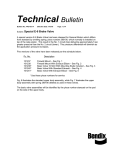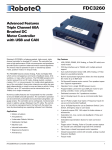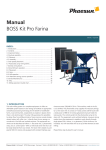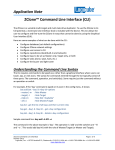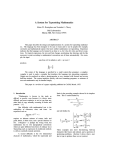Transcript
Some Suggested Problems In Chapter 1 and the Beginning of Chapter 2
Chapter 1
1.2
So that you can compare your answers with others, use the following intervals
(categories, classes): 500.5 – 650.5, ..., 3050.5 – 3200.5
Begin by completing the table below. (Some intervals contain no observations.)
Class
Boundaries
Frequency
Relative Frequency
—————————————————————————————————————————————————————————————
1
500.5-650.5
1
0.02
2
1
0.02
3
3
0.06
1.5
1.7
1.9
1.10
Additional part (d): How many students in interval 1.85 – 2.45?
Use the Empirical Rule throughout. Answer to (c): 81.5% approximately
Clue for (a): If n = 5, then the summation becomes c + c + c + c + c = 5c.
The computation for the variance can be done easily with just pencil and paper: 1.467.
If you have a calculator that has a STAT mode, or a key labeled DATA or Σ+, then you
can probably find standard deviations automatically; consult the calculator's user manual.
The formula for the variance in 9(c) is programmed into such calculators, using one
memory each to accumulate the values of n, Σxi and Σxi2.
As a demonstration, here is R-code. Figure out what each function does.
> x <- c(1,4,2,1,3,3)
> mean(x)
[1] 2.333333
> var(x)
[1] 1.466667
> sqrt(var(x))
[1] 1.211060
> sqrt((sum(x^2) - (1/length(x))*sum(x)^2)/(length(x)-1))
[1] 1.211060
1.11
Partial answer to (a): Σ yi = 62,622, Σ yi2 = 86,027,202 (also see back of book)
Partial answer to (b): Frequencies are 45, 48, 49, respectively (also see back of book)
Additional part (c): Repeat everything, omitting the two largest observations (which
greatly inflate s).
For (a), try R: Similar code to above. Begin with x <- c(964, 3168, ..., 1385). Of
course, you'll have to fill in the 47 values at ... . For (c) erase two of the 50 elements.
Beginning of Chapter 2
2.1
Partial answer: A ={FF}, C ∩ B c = {FM, MF}
2.5
Partial answer: A = {M1M2, M1M3, M2M3}, B c = A, A ∩ B c = A.
2.11, 2.13, 2.15 (Answers in back of book.)
For 2.15, here are two highly recommended ways of working such a problem:
First, make a Venn diagram. Inside the region for the sample space S, you should have four
regions corresponding to A∩B, Ac∩B, A∩Bc, and Ac∩Bc = (A∪B)c, where A = {Shaft defect},
B = {Bushing defect}, and c stands for complementation (written with an overbar in the text).
Label each region with its proportion. How do these regions correspond to parts (a)–(d)?
Second, make a 2-by-2 table such as shown in Exercise 2.12. Use row headings: Shaft defect,
Yes and NO; column headings: Bushing defect, Yes and No. Enter proportions into the four
"cells" of the table. How do the proportions in the cells correspond to proportions in the Venn
diagram; how do they correspond to answers for parts (a)–(d)?
Additional question for 2.15: Restrict attention to consider only assemblies with bushing defects:
What proportion of these also have shaft defects? Answer: 1/4. How obtained? Comment.
